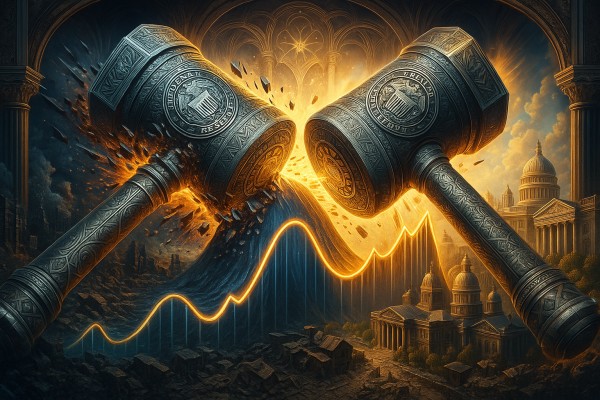Boom and Bust Cycles: The Fed’s Engineered Roller Coaster
Nov 2, 2025
For thousands of years, debt and despair have shared the same address. In Babylon, Hammurabi’s Code already acknowledged that economic collapse was not an accident but a pattern. His law offered debtors release after three years—a primitive reset mechanism for the same disease that infects us now: cycles of credit, ruin, and reprieve.
But modern collapse is not divine or natural; it is designed. Since 1913, the Federal Reserve has institutionalised the boom-bust sequence, turning what was once a corrective rhythm of capitalism into a perpetual machine of extraction. Growth is inflated through cheap credit, then crushed under the weight of its own leverage. Each “recovery” is financed by a deeper lie: that printing debt equals prosperity.
The purpose of this cycle is no longer balance—it is control. The ancient rulers forgave debt to preserve society. The modern ones extend it to own it.
The Psychology of Market Cycles: From Euphoria to Despair
At the root of every boom and bust lies not random chaos but a coordinated choreography between human greed and monetary engineering. The crowd provides the emotion; the Federal Reserve provides the fuel. Together, they form the perfect feedback loop of delusion.
Since the Fed’s creation in 1913, the U.S. dollar has lost over 90% of its purchasing power. A loaf of bread that cost 5 cents then now costs $2.50. That’s not inflation—it’s extraction on an industrial scale. Every cycle of “stimulus” and “tightening” transfers wealth upward: cheap money inflates assets held by the few, then contraction crushes wages and savings held by the many.
The herd mentality drives markets, but it’s the Fed that builds the corral. When rates are slashed, people rush to borrow, speculate, and believe. When rates rise, the same system pulls the floor out from under you. The masses lose; the institutions buy the wreckage. The pattern repeats because it’s designed to.
Warren Buffett once advised, “Be fearful when others are greedy, and greedy when others are fearful.” But what if fear and greed are scheduled by the very entity claiming to protect stability? The Fed manufactures both moods like a factory line—printing excess during euphoria, enforcing scarcity during despair.
Charles Mackay’s words in Extraordinary Popular Delusions and the Madness of Crowds still echo: “Men think in herds… they go mad in herds, and only recover their senses slowly, one by one.” He couldn’t have imagined that one day a central authority would weaponise that madness, turning human psychology into policy, and volatility into profit.
Understanding these forces isn’t just academic. It’s survival. Because every “cycle” isn’t natural: it’s manufactured. Each crest and collapse is scripted by policy, not chance. The Federal Reserve has mastered the art of monetising emotion—printing greed in the boom, then harvesting fear in the bust. What looks like chaos is choreography: liquidity in, euphoria out; liquidity out, despair in. The same hands that promise stability profit from the storm. Understanding that isn’t cynicism—it’s armour. Because in a system built on managed panic, survival means knowing who pulls the trigger, and refusing to play the part written for you.
The Central Bank’s Game: Printing Boom, Pricing Bust
The Federal Reserve was never designed to stabilise the economy—it was built to control it. Its power lies in its monopoly over the printing of money and in dictating its price. That single lever, the interest rate, determines who thrives and who drowns.
Every so-called “dilemma” the Fed faces is theatre. When it lowers rates, asset prices soar and wealth pools at the top. When it raises them, debt collapses, and the same elites buy the ruins for pennies. The rich harvest volatility; the poor absorb its cost. Since 2008, the Fed’s balance sheet has swollen from under $1 trillion to over $8 trillion, and yet half of Americans cannot afford a $500 emergency. This isn’t incompetence—it’s architecture.
Paul Volcker’s war on inflation in the 1980s crushed the middle class while cementing the Fed’s divine status. Alan Greenspan inflated the dot-com bubble with “easy money,” then repeated the act with housing. Ben Bernanke printed trillions to “save” the system, ensuring the same institutions that caused the crisis emerged larger. Jerome Powell now toys with rates like a child with matches, each spark igniting another speculative mania.
Volcker once admitted, “The truly unique power of a central bank is the power to create money, and ultimately, the power to destroy.” Few phrases in modern history have carried such quiet menace. To create is to inflate, to inflate is to devalue, and to devalue is to enslave—because debt grows as dollars decay.
The Fed speaks of “balancing growth and stability.” Yet the record shows only imbalance and engineered instability. Every cycle ends where it begins: wealth shifts upward, the currency is debased, and the working class is one rung lower. The central bank is not the referee of capitalism—it’s the casino’s owner, setting the odds, changing the rules, and cashing in on every hand.
Until society accepts that the Fed’s purpose is not to prevent destruction but to manage it for profit, the cycles will not end. They will only tighten, like a noose disguised as policy.
Technical Analysis: Interpreting the Fed’s Footprints
Technical analysis once claimed to study human behaviour expressed in price. Now it studies the behaviour of the central bank. Charts no longer map free markets; they trace policy tremors. Every rally, every collapse, carries the fingerprints of monetary intervention.
When the Fed cuts rates, liquidity floods the system. Risk assets spike, volatility compresses, and traders mistake distortion for recovery. When tightening begins, liquidity drains, leverage unwinds, and markets convulse. What appears as “support” or “resistance” on a chart is often nothing more than the lag between stimulus and withdrawal—a heartbeat of engineered addiction.
The trend concept still holds, but the source of momentum has changed. “The trend is your friend,” Jesse Livermore said, “until it ends.” In a Fed-driven market, the trend ends not with logic but decree. A press conference replaces price discovery. A few sentences from the FOMC move trillions, erasing months of analysis in a breath.
Support and resistance, moving averages, oscillators—all are now tools for measuring crowd reflexes to policy signals. Traders chase the ghost of real price action in a hall of mirrors built by the Fed’s balance sheet. The smarter ones no longer ask where the market is going, but what the Fed wants it to believe.
John Kenneth Galbraith once quipped that “the only function of economic forecasting is to make astrology look respectable.” Today, the Fed has turned astrology into monetary science—rituals of stimulus and sacrifice, interpreted by traders like priests reading omens in candle charts.
To trade in this era is to navigate a system where every pattern is political, every cycle deliberate, and every “correction” a redistribution of power. Technical analysis still matters—but only if one remembers that beneath every line and ratio lies the same truth: markets are no longer free, they are programmed.
Fear, Control, and the Illusion of Protection
Volatility is not chaos—it’s choreography. Every crisis engineered by monetary policy creates two groups: those who panic, and those who prepare. The Federal Reserve and its political auxiliaries rely on this divide. They print euphoria and sell despair, knowing that fear is the most efficient wealth-transfer mechanism ever devised.
Contrarian investors understand this. Baron Rothschild’s cold advice—“Buy when there’s blood in the streets, even if the blood is your own”—was not poetry; it was pattern recognition. Fear marks the point of maximum opportunity, because it is also the point of maximum manipulation. When the crowd is forced to liquidate, those with capital and courage accumulate. Every bust is a clearance sale for the patient few.
Diversification and dollar-cost averaging remain defences, but they are small shields in a system designed to wound. Since 2008, every policy response—quantitative easing, zero interest rates, fiscal stimulus—has inflated asset prices while punishing savers. Government intervention doesn’t “smooth” the cycle; it reinforces it. The same regulators who promise stability ensure dependence.
Adam Smith’s “invisible hand” has been replaced by an iron one. Keynes’s call for state intervention during crises was twisted into permanent management. Trillions are now conjured at will, each dollar worth less than before, each rescue deepening the next disaster. The Federal Reserve has become both arsonist and fire brigade, praised for extinguishing fires it lit itself.
Alan Greenspan once admitted, “I don’t think it’s possible to eliminate boom and bust cycles.” He was right, but not because markets are wild. They persist because volatility has become policy. The government’s role is not to end cycles but to manage the theatre of their recurrence—blaming greed, promising reform, then quietly resetting the game.
For investors, survival now means understanding that fear is the product being sold. To thrive, one must refuse to buy it. Hold conviction when the Fed demands compliance. Accumulate when liquidity vanishes. Think when others react. Because in a system built to extract through emotion, the only true act of rebellion is rationality.
The Great Confidence Game
Since 1913, the Federal Reserve has presided over the slow-motion destruction of the U.S. dollar. A currency that once bought a full meal now buys a candy bar. That’s not inflation—it’s policy. A century of “management” has erased nearly 90% of purchasing power, transferred wealth to asset holders, and convinced the working class that rising prices are progress. This is the great confidence game: the Fed creates the fire, sells the water, and invoices the victims.
Boom and bust are no longer natural rhythms of capitalism; they are manufactured exports of monetary engineering. The Fed calls it “counter-cyclical policy.” The public calls it pain. Every tightening cycle wipes out small investors. Every easing cycle rewards those already rich enough to borrow. The result is a market that pretends to be free while moving to the pulse of a committee that meets eight times a year to decide how expensive your life should be.
History doesn’t rhyme, it compounds. Each bailout demands a larger one. Each “soft landing” comes with harder consequences. Since 2008, over $8 trillion has been conjured into existence, yet half the country lives paycheck to paycheck. Money has become a hallucination sustained by faith in the very institution eroding it.
The satire writes itself: the arsonists now run the fire department, the economists call it equilibrium, and the public thanks them for saving the building that no longer stands.
To navigate this system is to accept one fact—there is no invisible hand, only a visible printer. The path forward isn’t trust; it’s awareness. Learn the pattern, see the manipulation, and act when the herd freezes. Fear is their tool. Rationality is your weapon.
The Fed cannot destroy value that is not for sale. Keep your mind, your time, and your capital out of their reach. That is the only form of wealth they cannot devalue.
Other Articles of Interest:















